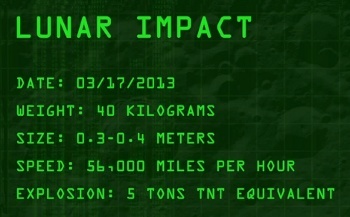Lunar Impact!
May 29, 2013
Three
decades ago, I was part of a company's attempts to align itself with the ill-fated goal of bringing the
US into the
metric system, a process called
metrication. At that time, the US had half-heartedly decided to "go metric," and there were even
road signs posted in both
miles and
kilometers. I even used proper metric units of
magnetism in a few of my papers, much to everyone's confusion. The
SI unit for
magnetic field strength is
amperes per meter, but everyone prefers the
oersted.
To add to the confusion, in a
vacuum (or in
air, if you're not too particular), the oersted is the same as a
gauss, the unit of
magnetic induction or
magnetic flux density, so we can write the conversion
equation,
1 A/m = 4πx10-3 gauss (in a vacuum)
If we keep everything in the
meter-
kilogram-
second system, as we should, we have
1 A/m = μo T
where T is the field strength in
tesla (= 10
4 gauss), and μ
o is the
permeability of free space
μo = 4πx10-7 henrys per meter.
People will persist in using
customary units, since these often make things easier to visualize. I still have a
carpenter's rule in my
workshop marked in
feet and
inches. Likewise, when we're talking about big
explosions, we don't talk in
joules; rather, we talk about
tons. The tons, of course, are tons of TNT,
2,4,6-trinitrotoluene (C
6H
2(NO
2)
3CH
3), a high explosive.
Just as
octane is the
standard for
motor fuels, the
TNT equivalent is used to quantify things that go boom. A ton of TNT (a
metric ton, of course) is defined as having an
energy equal to 4.184
gigajoules.
If the number, 4.184, seems familiar, it's the
conversion factor between
calories and
joules (1 calorie ≡ 4.184 J). In theory, the energy release of a
gram of TNT is 4853 joules, and
experiments have given a value of 4686, but convenience outweighs
accuracy in this case.
There was a rather large
meteor strike on the
Moon on March 17 of this year. The impact was so intense that you would have noticed the flash of light from it with your
unaided eye. It was at
stellar magnitude 4, which made it nearly as bright as the
Andromeda Galaxy.
NASA has characterized this meteor strike, and they've created the following scorecard of this explosion. The energy, of course, is listed in tons of TNT.[3]

Scorecard for the March 17, 2013, meteor impact at Mare Imbrium.
(Still image from a NASA YouTube Video.)
The impact was in the
Mare Imbrium region of the moon, as shown in the photograph, below. NASA has been monitoring meteor impacts on the Moon for the past eight years, and the flash of light from this impact was nearly an
order of magnitude greater than anything seen to date.[2] This however, would pale in comparison with the
theorized formation of the Moon's
Giordano Bruno crater.[3]
Five
monks from the
Canterbury Abbey reported a massive flare from the Moon's direction on June 18, 1178. The
geologist, Jack B. Hartung, theorized in 1976 that this was the meteor impact that formed the Giordano Bruno crater.[4] Such an impact, however, would have had notable side-effects, including a
meteor storm on Earth, which were not observed. It's possible that the monks, instead, saw a meteor exploding in Earth's atmosphere right above them.[3]

The Mare Imbrium region of the Moon.
(NASA Image.)
(Click on the image for a larger version with registered impacts from 2005 to present, with the recent impact highlighted in red.)[2)]
The experience of the lunar meteor monitoring program is that meteor strikes on the Moon are quite common. The March 17, 2013, Mare Imbrium impact appears to be associated with a meteor stream that also dropped some fireballs into Earth's atmosphere. More than half the lunar impact events come from the known meteor showers, such as the
Leonids and
Perseids. The other half are from
random events, which are called sporadic meteors.[2]
The motivation for such
research is to determine the
safety of extended
lunar exploration, and what times of year may be most inhospitable for
moonwalks. The NASA
Lunar Reconnaissance Orbiter may be able to image the crater, supposedly about twenty
meters wide, resulting from the March impact. Such imaging will validate lunar impact
models.[2]

An artist's conception of a major lunar meteor strike. The meteor's kinetic energy is converted into the heat of molten rock and their associated vapors. (Still image from a NASA YouTube Video.)
References:
- Tony Phillips, "Bright Explosion on the Moon," Science@NASA Web Site, May 17, 2013.
- NASA ScienceCast: Bright Explosion on the Moon, YouTube Video, May 16, 2013.
- The Mysterious Case of Crater Giordano Bruno, Science@NASA Web Site, April 26, 2001.
- J. B. Hartung, "Was the formation of a 20-km-diameter impact crater on the moon observed on June 18, 1178?" Meteoritics, vol. 11 (September 30, 1976), pp. 187-194.
Permanent Link to this article
Linked Keywords: Decade; United States; US; metric system; metrication; traffic sign; road sign; mile; kilometer; magnetism; International System of Units; SI unit; magnetic field strength; ampere; oersted; vacuum; air; gauss; magnetic induction; magnetic flux density; equation; meter; kilogram; second; tesla; vacuum permeability; permeability of free space; henry; customary unit; carpenter's rule; workshop; foot; inch; explosion; joule; ton; trinitrotoluene; 2,4,6-trinitrotoluene; octane; octane rating; standard; motor fuel; TNT equivalent; tonne; metric ton; energy; gigajoule; conversion factor; calorie; joule; gram; experiment; accuracy and precision; meteorite; meteor strike; Moon; naked eye; unaided eye; apparent magnitude; stellar magnitude; Andromeda Galaxy; NASA; YouTube Vide; Mare Imbrium; order of magnitude; theory; Giordano Bruno crater; monk; St Augustine's Abbey; Canterbury Abbey; geologist; meteor shower; meteor storm; fireball; Leonids; Perseids; randomness; random event; research; safety; lunar exploration; moonwalk; Lunar Reconnaissance Orbiter; meter; mathematical model; kinetic energy; heat; melting; molten; rock; vapor.